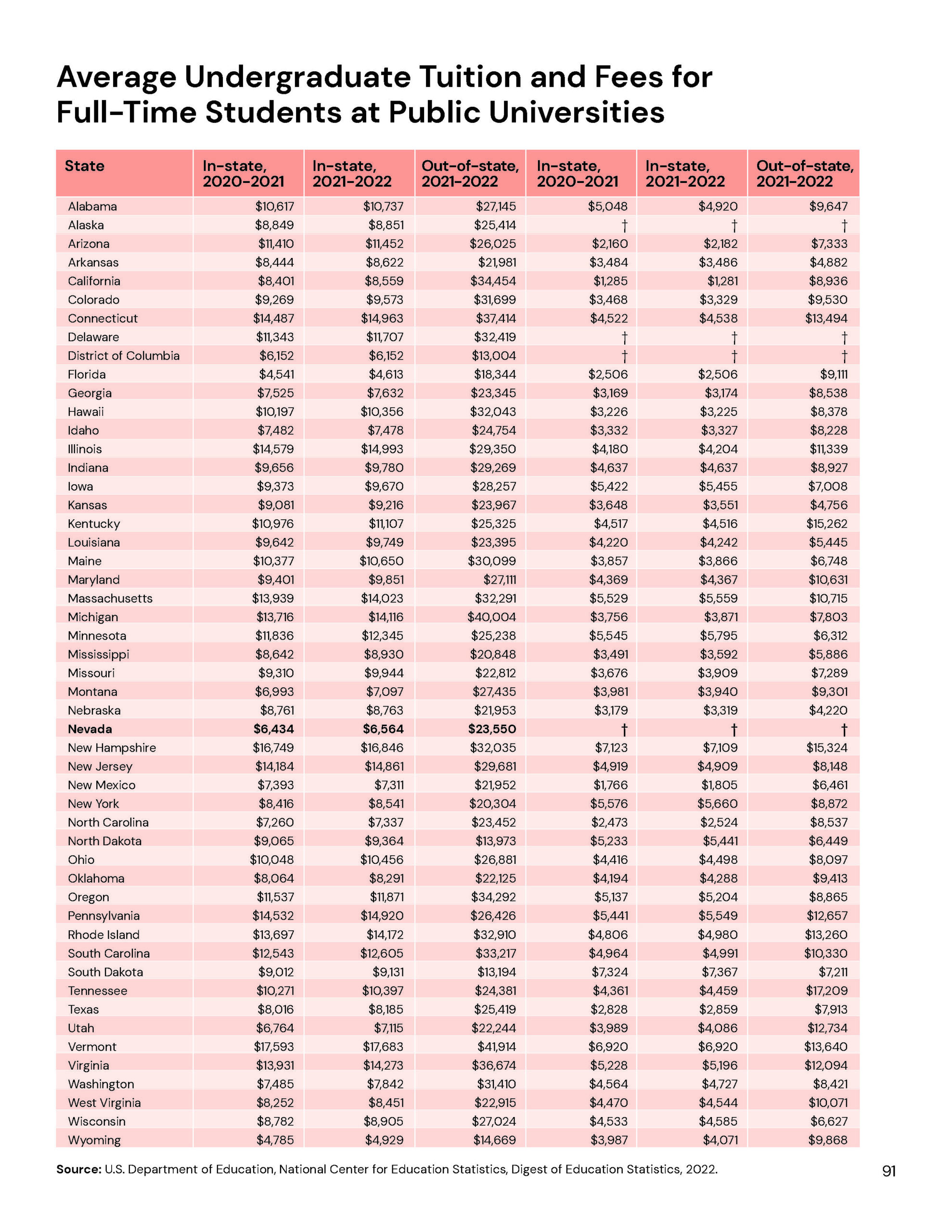NSHE Finance
NSHE Finance
State general-fund support for the Nevada System of Higher Education (NSHE) amounts to $1.470 billion in the 2023-2025 budget. In addition to state appropriations, NSHE receives student tuition and fees, and other self-supported funds and grants. In FY 2022, student tuition and fees amounted to $477 million and other self-supported funds totaled to $939 million. Combined with $640 million in state general-fund support for that single year, total system revenues amounted to $2.056 billion.1
Yet, despite modest increases in student fees in recent years, the share of costs borne directly by students is remarkably low when NSHE institutions are compared to public universities around the nation.
Key Points
Nevadans face some of the lowest in-state tuition rates in the nation. According to the U.S. Department of Education, the average cost of in-state tuition and fees to attend a four-year, public university in Nevada was $6,564 for the 2021-22 school year. That amount was the fourth-lowest in the nation and $3,106 below the national median.2
Use of general fund dollars for NSHE is regressive. Studies show that children of more affluent families are far more likely to attend college than children of low-income families.3 Yet, state taxes in Nevada are paid by individuals at every point along the income scale. Therefore, general-fund spending on NSHE tends to have a statistically regressive impact, transferring resources from the less to the more wealthy.
NSHE fails far too many students. Among students who enroll as first-time college freshmen at the University of Nevada, Reno, only 60.1% graduate within six years. At the University of Nevada, Las Vegas, the rate is even lower – at 44.3% percent. The four-year graduation rate is a meager 39.0% at UNR and 17.2% at UNLV.4
Subsidized tuition rates discourage private competition. The highly subsidized tuition rates offered by NSHE institutions impair the ability of high-quality private universities to open in Nevada and compete for students. This absence of competition, in turn, allows NSHE’s poor performance to continue unchecked.
The nation’s most successful public universities – from the University of California, Berkeley to Penn. State University –achieved prominence as a result of competing directly with major private universities nearby. Not coincidentally,these top-ranked public universities also charge tuition rates that are less dramatically subsidized than those foundin Nevada.
Recommendations
Fund students, not institutions. Instead of subsidizing a failing state monopoly on higher education, lawmakers should harness the power of markets to raise the quality of Nevada’s higher education marketplace. This can be done by determining a value of state support to be guaranteed each full-time student and then allocating funds to institutions in accord with their in-state student enrollment.
Any university in Nevada whose quality attracts students – whether an NSHE institution or not – should be eligible to receive this support. Over time, this will allow top-notch private universities to develop within the state, bringing the competition in the higher-education marketplace that Nevada needs.
Allow regents to set and keep tuition rates. A consequence of this approach is that NSHE administrators should set and keep the tuition rates charged by NSHE institutions. The combination of tuition and per-pupil state support attracted by each institution should remain with the institution itself and not be subject to legislative manipulation.

1 Nevada System of Higher Education, Financial Statements for the Year Ended June 30, 2022.
2 U.S. Department of Education, National Center for Education Statistics, Digest of Education Statistics, 2022.
3 See, e.g., Jacqueline E. King, “Improving the Odds: Factors that Increase the Likelihood of Four-Year College Attendance Among High School Seniors,” College Entrance Examination Board, 1996.
4 U.S. Department of Education, Integrated Postsecondary Education Data System, 2020.
